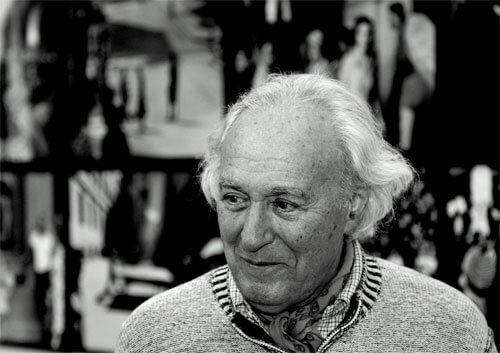William Klein (born in New York, New York, USA, on April 19, 1928) is a photographer and filmmaker noted to for his ironic approach to both media and his extensive use of unusual photographic techniques in the context of photojournalism and fashion photography. He was ranked 25th on Professional Photographer's Top 100 Most influential photographers. Trained as a painter, Klein studied under Fernand Léger and found early success with exhibitions of his work. However, he soon moved on to photography and achieved widespread fame as a fashion photographer for Vogue and for his photo essays on various cities. Despite having no training as a photographer, Klein won the Prix Nadar in 1957 for New York, a book of photographs taken during a brief return to his hometown in 1954.
Klein's work was considered revolutionary for its "ambivalent and ironic approach to the world of fashion", its "uncompromising rejection of the then prevailing rules of photography" and for his extensive use of wide-angle and telephoto lenses, natural lighting and motion blur. Klein tends to be cited in photography books along with Robert Frank as among the fathers of street photography, one of those mixed compliments that classifies a man who is hard to classify. The world of fashion would become the subject for Klein's first feature film, Who Are You, Polly Maggoo?, which, like his other two fiction features, Mr. Freedom and The Model Couple, is a satire. Klein has directed numerous short and feature-length documentaries and has produced over 250 television commercials. Though American by birth, Klein has lived and worked in France since his late teens. His work has sometimes been openly critical of American society and foreign policy; the film critic Jonathan Rosenbaum once wrote that Klein's 1968 satire Mr. Freedom was "conceivably the most anti-American movie ever made."
Klein was born into an impoverished Jewish family. Klein graduated from high school early and enrolled at the City College of New York at the age of 14 to study sociology. Klein joined the US Army and was stationed in Germany and later France, where he would permanently settle after being discharged. In 1948, Klein enrolled at the Sorbonne, and later studied with Fernand Léger. At the time, Klein was interested in abstract painting and sculpture. In 1952, Klein had two successful solo exhibitions in Milan and began a collaboration with the architect Angelo Mangiarotti. Klein also experimented with kinetic art, and it was at an exhibition of his kinetic sculptures that he met Alexander Liberman, the art director for Vogue. In 1966, Klein directed his first feature film, Who Are You, Polly Maggoo? He has since directed many others, including the cinéma vérité documentary Grands soirs et petits matins, the 1964 documentary Cassius the Great, re-edited with new footage as Muhammed Ali, The Greatest in 1969, and the satires Mr. Freedom and Le Couple Témoin. A long time tennis fan, in 1982 he directed The French, a documentary on the French Open tennis championship at Roland-Garros. He was awarded The Royal Photographic Society's Centenary Medal and Honorary Fellowship (HonFRPS) in recognition of a sustained, significant contribution to the art of photography in 1999.
In 2012, Klein received the Outstanding Contribution to Photography Award at the annual Sony World Photography Awards in recognition of his work in the field of photography.
Source: Wikipedia
